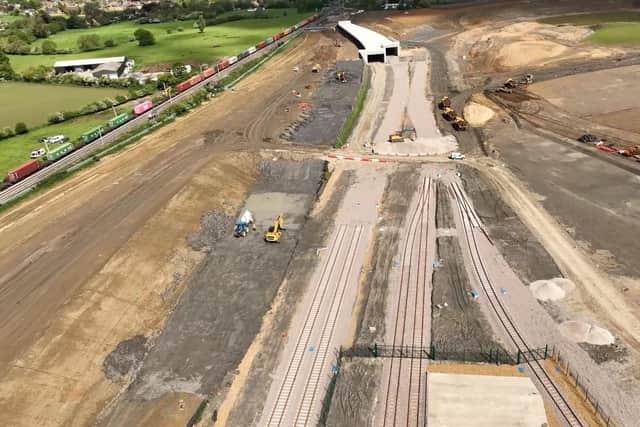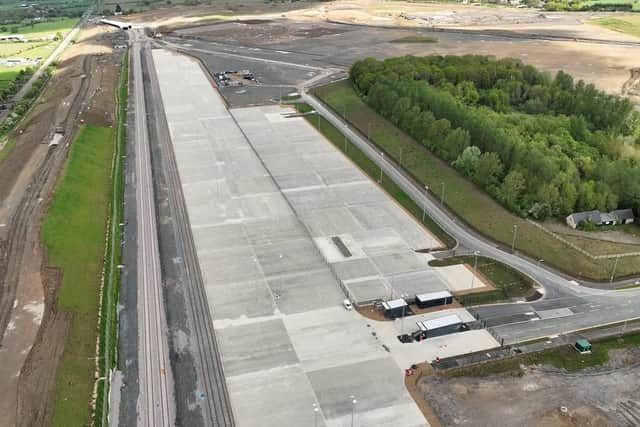WATCH: New drone footage of huge rail freight interchange in Northampton as work reaches next milestone
and live on Freeview channel 276
Drone footage has been released of the huge rail freight interchange in Northampton as another phase in the works is set to begin soon.
The footage shows where the new link to the Strategic Rail Freight Interchange at SEGRO Logistics Park Northampton near junction 15 of the M1 will soon be built.
Advertisement
Hide AdAdvertisement
Hide AdThe new railway connection, which will be used by freight company Maritime, will see thousands of tonnes of goods switch between rail and road every day.


Engineers are currently completing the railway sidings for the already constructed container terminal, which means there will be disruption to services between Northampton and Milton Keynes in September.
Railway teams will connect the under-construction interchange to one of Europe’s busiest mixed-use passenger and freight railway lines, by installing new track, points and signalling systems.
This next stage of work will mean a section of the West Coast main line will close between September 2 and 10 when there will be no direct services between North Wales and London, journeys will take longer on diversionary routes, could involve rail replacement buses and train timetables will be different.
Advertisement
Hide AdAdvertisement
Hide AdWhat train companies have said about the closure


James Dean, West Coast South route director, said: “We’re delighted to continue working closely with freight partners in delivering this new Strategic Rail Freight Interchange at Northampton.
“This will help deliver better, faster, stronger services to support Britain’s economy and the decarbonisation of transport.”
Barry Milsom, Avanti West Coast executive director of operations and safety, added: “While this important phase of work takes place, we’ll be operating a slightly reduced timetable.
“As a result, our trains may be busier.
“We would like to thank customers for their patience as Network Rail delivers a sustainable transport option for freight on the West Coast main line.”
Advertisement
Hide AdAdvertisement
Hide AdJonny Wiseman, London Northwestern Railway customer experience director, continued: “Rail replacement buses will be running between Milton Keynes and Northampton so passengers travelling during this period should leave extra time.”
Passengers are being advised to check before they travel by visiting www.nationalrail.co.uk to plan their journey.
What will the rail freight terminal be used for when it is finished?
When completed next year, the massive facility will have five million square feet of warehouse space and employ up to 7,000 people.
To begin with four freight trains will serve the new Northampton interchange each day - with the capacity for more in future.
Advertisement
Hide AdAdvertisement
Hide AdEach freight train is said to take up to 76 heavy goods vehicles off the road, making it a much greener way to transport economically important goods around the country.
Kate Bedson, SEGRO senior director of national logistics, said: “We are confident that the short term disruption while this vital work is undertaken will be far outweighed by the longer term benefits of the overall development and the rail freight capability at this location.”
John Williams, Maritime executive chairman, added: “These developments, at SEGRO Logistics Park Northampton are important, long-term commitments for Maritime to reduce our environmental footprint by developing a network of low carbon, strategic freight connections across the country to promote modal shift from road to rail for container transport and for domestic distribution, with local distribution by electric-powered trucks,” Mr Williams continued.